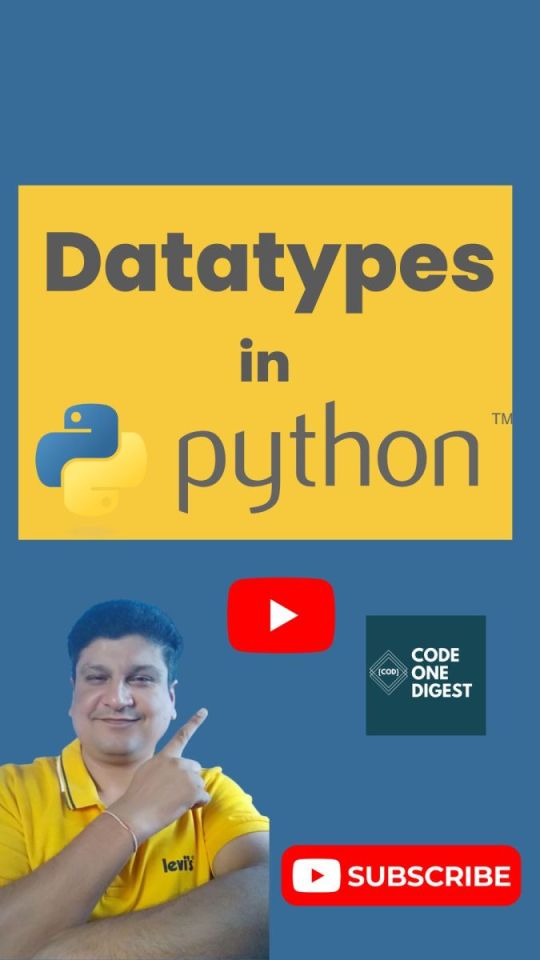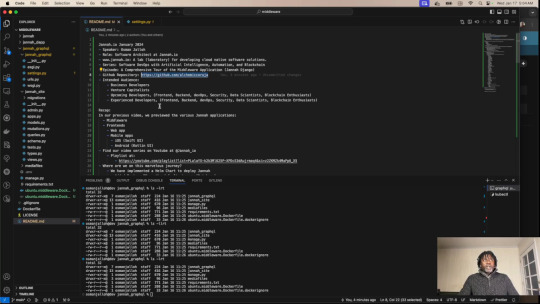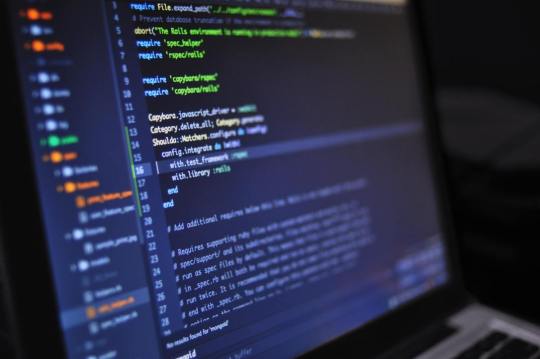#python data type
Text
YouTube Short - Quick Cheat Sheet to Python Data types for Beginners | Learn Python Datatypes in 1 minute
Hi, a short #video on #python #datatype is published on #codeonedigest #youtube channel. Learn the python #datatypes in 1 minute.
#pythondatatypes #pythondatatypes #pythondatatypestring #pythondatatypedeclaration #pythondatatypeprogram
What is Data type?
Python Data Types are used to define the type of a variable. Datatype defines what type of data we are going to store in a variable. The data stored in memory can be of many types. For example, a person’s age is stored as a numeric value and his address is stored as alphanumeric characters.
Python has various built-in data types.
1. Numeric data types store numeric…

View On WordPress
#Boolean#complex#dictionary#integer#list#long#numeric#python data type#python data type Boolean#python data type complex#python data type declaration#python data type dictionary#python data type float#python data type integer#python data type list#python data type numeric#python data type of variable#python data type range#python data type set#python data type string#python data type tuple#python data types#python data types cheat sheet#python datatype program#python datatype string#python datatypes#range#string#tuple
1 note
·
View note
Text
Data Types in Python
Introduction
Hi All. In this post, I will tell you about the data types supported in python. Python provides several built-in data types that are commonly used. Here’s an overview of some of the main data types:
Numeric Types:
Python provides three types of numeric types:
Integer (int): Integers are whole numbers without a decimal point. They can be positive, negative, or zero. Example: 5,…

View On WordPress
#python boolean type#python bytearray#python data types#python Dictionary#python Frozen Set#python list#python memoryview#python range#python Set#python strings#python tuple
2 notes
·
View notes
Text
Another type of data, used in python, is numerical data.
Unlike strings, numerical values are not quoted with quotation marks:
price = 30
Tip:
Big numbers can be written in a more readable way:
thousand = 1_000
print(thousand)
Output: 1000
million = 1_000_000
print(million)
Output: 1000000
a_really_long_number = 1_000_000_000
print(a_really_long_number)
Output= 1000000000
This way, it would be less confusing for a person dealing with the code!
Numbers can be used to perform some calculations and operations.
Examples:
Operation: Output:
print(110) 110
print(8 + 2) 10
print(10 - 5) 5
print(5 * 3) 15
print(10 / 5) 2.0
Float division: (10 / 5) would give a float number, meaning a number with digits after the coma (like 2.0)
Integer division: using division sign twice (10//5), would give an integer (like 2), without digits after the coma.
Exponentiation: 2**3 = 2*2*2, 5**3=125
👀 Details matter:
num1 = 10
num2 = "10"
Python recognizes num1 as a number and num2 as a string.
It would perform commands differently because of this:
print(2*num1) Output: 20
print(2*num2) Output: 1010
Another example:
print(2*"3+7") Output: 3+7 3+7
print(3+7) Output: 10
print("3+7") Output: 3+7
0 notes
Text
Mutable and Immutable in Python, offered by Hero Vired, provides a comprehensive exploration of different object data types in Python. The course covers the concepts of mutable and immutable objects, their differences, and their impact on programming. It is a valuable resource for better understanding Python's object data types.For More Information, Please Visit The Blog.
0 notes
Video
youtube
ইনপুট নেওয়া শুরু করি Python বাংলায় পাইথন প্রোগ্রামিং Input Data type
0 notes
Text
Getting Started with Python: A Beginner's Guide (pt 2)
They say teaching is the best way to learn. Consider subscribing to the website!
Expanding Your Knowledge: Collections and Control Flow
In Part 1 of our beginner’s guide to Python, we covered the basics of variables, data types, and conditional statements. Now, let’s dive deeper into collections like lists, tuples, and dictionaries, as well as control flow mechanisms such as loops and functions.
Lists: More Than Just Arrays
As mentioned earlier, a list is a collection of…
#Beginner#Coding#Dictionaries#Functions#Getting started with Python#Introduction to Python programming#Learn Python#Lists#Loops#Programming#Python#Python basics#Python conditional statements#Python control structures#Python data types#Python for beginners#Python operators#Python variables#Tuples
0 notes
Text
Types of Programming Paradigms in Python You Should Know
Are you eager to elevate your Python skills and broaden your programming knowledge? Whether you’re looking to deepen your understanding of Python or exploring new ways to approach problem-solving in programming, this blog post is tailored for you. Equip yourself with the knowledge of different programming paradigms in Python and enhance your coding proficiency today!
Read the full blog post here.
0 notes
Text
A Comprehensive Presentation on Jannah Middleware Application Part 7: Continuing with GraphQL API Query Handlers
Continuing Showing the GraphQL API Query Resolver Functions.
A Comprehensive Presentation on Jannah Middleware Application Part 7: Continuing with GraphQL API Query Handlers
Video Highlights
We talked about pagination implementation for the workflows query as a proof of concept.
For each graphql API type, there is a corresponding handler to resolve it queries.
We defined the following query handlers…

View On WordPress
#&039;gotcha&039;#compute#computer science#CRUD#Data#Database#Discovery#django#Educational Trip#Eye-Opening#graphene#GraphQL#graphs#handler#istio#jannah.io#kubeflow#Models#PostgresDB#python#quirks#resolver#Sightseeing#Software Developer#Software Engineering#Software Services#Students#Tech Business Developers#Tech Venture Capitalists#Types
0 notes
Text
What are the data types in Python?

Python training It supports several built-in data types, which are fundamental for working with data and performing various operations. Here are the most common data types in Python:
Numeric Types
int: Represents integer values, both positive and negative.pythonCopy codemy_int = 42
float: Represents floating-point (decimal) numbers.pythonCopy codemy_float = 3.14159
complex: Represents complex numbers with a real and imaginary part.pythonCopy codemy_complex = 2 + 3j
Text Type
str: Represents strings, which are sequences of characters enclosed in single or double quotes.pythonCopy codemy_string = "Hello, Python!"
Sequence Types
list: Represents ordered collections of items. Lists can contain elements of different data types and are mutable.pythonCopy codemy_list = [1, 2, 3, "Python", True]
tuple: Similar to lists but immutable, meaning their contents cannot be changed once created.pythonCopy codemy_tuple = (1, 2, 3, "Python", True)
range: Represents a sequence of numbers, commonly used for iterations.pythonCopy codemy_range = range(1, 6) # Represents [1, 2, 3, 4, 5]
Mapping Type
dict: Represents dictionaries, which are collections of key-value pairs. Dictionaries are unordered.pythonCopy codemy_dict = {"name": "Alice", "age": 30, "city": "New York"}
Set Types
set: Represents an unordered collection of unique elements.pythonCopy codemy_set = {1, 2, 3, 4, 5}
frozenset: Similar to sets but immutable, meaning their contents cannot be changed after creation.pythonCopy codemy_frozenset = frozenset({1, 2, 3})
Boolean Type
bool: Represents Boolean values, either True or False.pythonCopy codeis_valid = True
Binary Types
bytes: Represents a sequence of bytes and is immutable.pythonCopy codemy_bytes = b"Hello"
bytearray: Similar to bytes but mutable.pythonCopy codemy_bytearray = bytearray([72, 101, 108, 108, 111])
None Type
NoneType: Represents the absence of a value or a null value. It is often used to indicate that a variable does not point to any object.pythonCopy codemy_var = None
0 notes
Text
Day-1: Demystifying Python Variables: A Comprehensive Guide for Data Management
Python Boot Camp Series 2023.
Python is a powerful and versatile programming language used for a wide range of applications. One of the fundamental concepts in Python, and in programming in general, is working with variables. In this article, we will explore what variables are, how to use them effectively to manage data, and some best practices for their usage.
What are Variables in Python?
Definition of Variables
In…

View On WordPress
#best practices for variables#data management in Python#dynamic typing#Python beginners guide#Python coding tips#Python data manipulation#Python data types#Python programming#Python programming concepts#Python tutorials#Python variable naming rules#Python variables#variable scope#working with variables
0 notes
Text
#AI#BigData#CloudComputing#DataAnalytics#DataPlatforms#DataScience#IoT#IIoT#PyTorch#Python#RStats#TensorFlow#Java#JavaScript#ReactJS#GoLang#Serverless#4 types of data analytics#analytics#aws iot analytics#big data#big data analytics#data analysis#data analytics#data analytics career#data analytics job#data analytics project#data analytics roadmap#data analytics trends#data handling in iot
0 notes
Text
python a small and really not that good example of a basic typing tutor using curses
import curses import time # https://pythonprogrammingsnippets.tumblr.com def get_timestamp_ms(): return int(round(time.time() * 1000)) def get_diff_ms(start, end): return end - start def main(stdscr): num_wrong = 0 time_start = get_timestamp_ms() # Turn off cursor visibility curses.curs_set(0) # Set colors curses.init_pair(1, curses.COLOR_GREEN, curses.COLOR_BLACK) curses.init_pair(2, curses.COLOR_RED, curses.COLOR_BLACK) curses.init_pair(3, curses.COLOR_WHITE, curses.COLOR_BLACK) curses.init_pair(4, curses.COLOR_BLACK, curses.COLOR_BLACK) # Set the sentence sentence = "The quick brown fox jumps over the lazy dog" # Clear the screen stdscr.clear() # Print the sentence in grey on black stdscr.addstr(sentence, curses.color_pair(3)) # Set the cursor at the beginning of the sentence cursor_x = 0 cursor_y = 0 stdscr.move(cursor_y, cursor_x) # Keep track of which characters have been typed correctly correct_chars = [False] * len(sentence) # Read input from user while True: c = stdscr.getch() # If the user presses backspace, move the cursor back one character if c == curses.KEY_BACKSPACE or c == 127: if cursor_x > 0: # Move the cursor back one character cursor_x -= 1 stdscr.move(cursor_y, cursor_x) # If the character was previously correct, change it back to grey if correct_chars[cursor_x]: stdscr.addstr(sentence[cursor_x], curses.color_pair(3)) correct_chars[cursor_x] = False else: # Otherwise, change it to black stdscr.addstr(sentence[cursor_x], curses.color_pair(4)) continue # If the user presses enter, break out of the loop if c == curses.KEY_ENTER or c == 10: break # Get the character that the user typed ch = chr(c) # If the character is not part of the sentence, ignore it if ch != sentence[cursor_x]: # Change the color of the erroneous character to red stdscr.addstr(ch, curses.color_pair(2)) num_wrong += 1 # Wait for a brief moment before changing the color back to grey curses.napms(200) stdscr.addstr(ch, curses.color_pair(3)) else: # Change the color of the correct character to green stdscr.addstr(ch, curses.color_pair(1)) correct_chars[cursor_x] = True # Move the cursor forward one character cursor_x += 1 # If the cursor is at the end of the sentence, break out of the loop if cursor_x == len(sentence): break # Move the cursor to the next character stdscr.move(cursor_y, cursor_x) time_end = get_timestamp_ms() time_diff = get_diff_ms(time_start, time_end) time_diff_secs = time_diff/1000 # print the time taken, number of words, words per minute and accuracy stdscr.addstr(2, 0, "Time taken: " + str(time_diff_secs) + " seconds") stdscr.addstr(3, 0, "Number of words: " + str(len(sentence.split()))) stdscr.addstr(4, 0, "Words per minute: " + str(len(sentence.split())/(time_diff_secs/60))) # print the amount wrong stdscr.addstr(6, 0, "Amount wrong: " + str(num_wrong)) # print the accuracy stdscr.addstr(7, 0, "Accuracy: " + str((len(sentence) - num_wrong)/len(sentence) * 100) + "%") # Refresh the screen stdscr.refresh() # Wait for a moment before exiting curses.napms(10000) curses.wrapper(main)
#python#typing#game#fun#typing tutor#wpm#wpm checker#words per minute#tutor#skills#improve typing#improve#self improvement#typing accuracy#information processing#data entry#simple#example#tutorial#training#curses#console#terminal#ascii#ansi#timestamp#timing#timer#ms#consoleio
0 notes
Text
Programs use different data types in their work.
Python has two main data type groups:
1) Premitive data type:
Examples: String, Integer, Float, Boolean
2) Non-premitive data type:
Examples: List, Tuple, Array, File, Set
Let's start with strings 💕
Text data is called a string. Example:
"Wassup?"
But although string is usually presented as a text, it's better to consider it as a "string of characters". Examples of what is a character and how it can be presented as a string in python:
"Hi!", "19", "Hello", "A", "🐈".
Although examples above were not only letters, but also a number and an emoji, putting them inside the quotation marks makes python see and use those as strings.
" " is also a string, containing a space 🫡
In Python, you can use single ' or double " quotation marks to define a string. But! You need to stick to one format per string. If quotes aren't matching, you are in trouble :)
Examples:
✅️ "HELLO"
✅️ 'HELLO'
❌️ "Hellllllooooooo'
0 notes
Text
How much data can a python list hold?
How much data can a python list hold?
A Python list is a collection of items stored in a single place in memory. Lists are ordered, changeable, and allow duplicate values. Lists are created using square brackets [] and can contain any data type, including other lists.
What is the maximum length of any list in Python
The maximum length of any list in Python is determined by the amount of available memory on the system. In practice,…
View On WordPress
#How Big Can a Python List Get#How much data can a python list hold#types of lists in Python#What is the maximum length of any list in Python
0 notes
Video
youtube
Python tuples: unveiling their power with a complete programming example
#youtube#This video is all about the Tuple data type in Python: what a Tuple is how to declare a tuple object how to access its member objects with i
0 notes